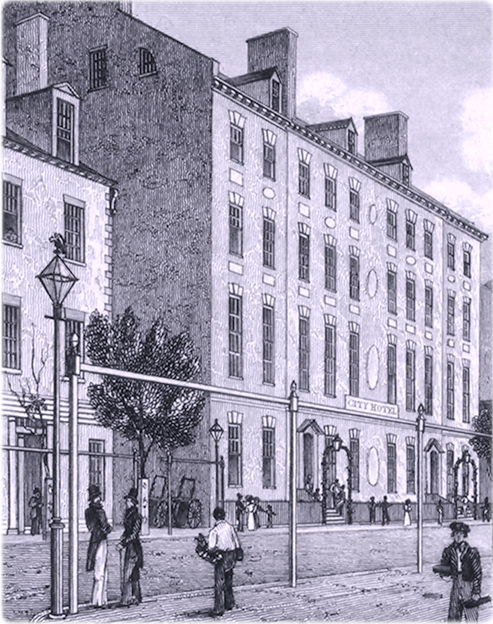
City Hotel
The Tontine Hotel opened in 1795, on the west side Broadway, between Cedar and Thames streets. Soon it became known as the City Hotel, the first functioning hotel in New York, after the taverns and boarding houses.
The site was outside the City Wall, demolished after 1695. About 1700 (or later), Stephen Delancey (born Etienne de Lancey), built a dwelling house at the present 115 Broadway. In 1741, it became the property of John Peter de Lancey. In 1754, it became a tavern, called the Province Arms or City Tavern.
In January 1793, the City Tavern was offered for sale. The property was described as 100 feet in front on Broadway and 15o feet in length (the building only 80 feet deep). On March 23, John Peter De Lancey and wife conveyed the old City Tavern to nine gentlemen in trust for the subscribers of the “N. Y. Tontine Hotel and Assembly Room”. Tontine was a system for raising capital (see more at the Tontine Coffee-House, built months earlier on Wall Street). In 1792, a similar association was made in Albany to erect the "City Tontine Hotel". At the time, other Tontine hotels were erected in Georgetown, Glasgow and Birmingham, for example.
In November, 1793, the committee in charge of the construction of the Tontine Hotel advertised that they would pay “twenty guineas premium for the best plan of the buildings they contemplate having erected.” In August 1794, the Common Council gave a permit to build the Tontine Hotel, which began to be erected in the same year and opened in 1795. By the late 1796, it was still under construction, but partly in use. It was completed about the early 1800, however, after purchasing the hotel in 1801, Ezra Weeks reported it was in its unfinished state.
The four-story hotel (turned 5-story in 1833) was possibly designed by John McComb Jr. (1763-1853). It became known as the Tontine City Hotel and was also a place for concerts, balls and other social functions. It was a large brick building, containing a spacious ball room, tea room, card room and was used by the City Assembly. Robert Hunter was the first manager and he left in 1799.
On February 6, 1800, the property "commonly distinguished by the name of the Tontine City Hotel" was offered for sale in the New York Commercial Advertiser. It was again offered for sale on February 7, 1801, with an additional notice: "If not previously disposed of, it will be sold at public auction at the Tontine Coffee House on the first Tuesday in March next". The venue continued to be operated as a hotel. The Bank of New York became the owner of the City Hotel, possibly after a foreclosure, and sold the property to Ezra Weeks (1772-1849) on November 20, 1801. Weeks reported the hotel cost more that 100,000 dollars and was sold for 48,000 dollars. Weeks was a builder, appointed in 1803 as the master carpenters for the construction of the new City Hall. He intended to convert the lower part of the building into stores, and finish the upper part for dwelling. By this point, it seems, the hotel's tontine business plan was no longer valid.
The hotel was renovated and opened as the "City Hotel" in May, 1802. John Lovett was the manager. In April 1807, French Chenelette Dusseaussoir became the manager. in 1809, he was replaced by Solomon D. Gibson. In June, 1817, Chester Jennings took the City Hotel, which was renovated. The shops were converted to the use of the hotel. The hotel also contained a library, reading room, drawing room, numerous private parlors and a dining room, 80 feet in length, connected with another of 45 feet, forming an "L".
On April 8, 1828, the City Hotel was sold by Ezra Weeks and others at public auction at the Merchants' Exchange. The property was bought by John Jacob Astor and continued to be operated by Chester Jennings. On April 25, 1833, City Hotel caught fire, destroying the upper and attic stories. It reopened on July 16, enlarged and improved, with an added story. By 1840, Gardner & Packer were the proprietors (their partnership in July 1841).
City Hotel was the most famous in New York until the opening of the Astor House, in 1836, built by John Jacob Astor. About 1843, the All Nations' Hotel was at 111 Broadway, on the south side of Thames St. The New England Hotel was constructed about 1844 on the same site, demolished in 1852.
The City Hotel closed on April 30, 1849. It was replaced with stores (see the "Old City Hotel" in an illustration about 1850s). By 1878, the structure of the old building was deteriorated and it was torn down to make way for the eight-story above ground Boreel Building, completed in May 1879.
The old City Hotel on Broadway, in 1831 (click on the image for more).
|
Copyright © Geographic Guide - Images of NYC, Historic Buildings. |

By Jonildo Bacelar
City Hotel